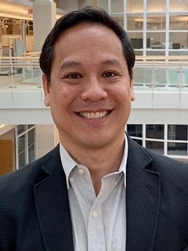Javier Jo is a professor in the School of Electrical and Computer Engineering, Gallogly College of Engineering. His research is in the area of optical imaging.
Born, raised, and educated in Lima, Peru, he holds a bachelor’s degree in electrical engineering from the Pontificia Universidad Catolica del Peru. He also holds a master’s in electrical engineering and a doctorate in biomedical engineering from the University of Southern California, Los Angeles.
“My parents were Chinese descendants, so most of my relatives were Chinese Peruvian. However, the majority of my friends from my neighborhood, school, and college were Peruvian. Compared to the U.S., Peru is a small country with limited resources,” he said. “I was very lucky that my parents could afford the best education available for their children.”
While living in Los Angeles, Jo was exposed to diverse academic and research environments. He joined the faculty at Texas A&M University in 2006, where he began a research group with an emphasis on Hispanic researchers. He came to OU in 2019.
“I have been able to recruit and graduate Ph.D. students from Mexico, Peru, and Brazil,” he said. “We currently maintain research collaborations with colleagues throughout Latin America. Since the mission of my lab is to develop technologies that could solve pressing problems in medicine, we often look also at medical and clinical problems that are of special relevance in Latin America and try to develop solutions to them with our Latin American collaborators.”
While his doctoral work in biomedical engineering was focused on developing algorithms and models showing how the cardiovascular system is affected by obstructive sleep apnea syndrome, his postdoctoral research was in the field of biomedical optics. The overall mission of his current research program is to develop optical sensing and imaging technologies that will impact how pathophysiological mechanisms underlying major human diseases are studied and how patients suffering from those diseases are clinically managed.
“I have been developing novel optical technologies that can enable extracting molecular and physiological information in a clinical setting,” he said. “Our hope is that some of these imaging technologies would help improve the diagnosis and treatment of serious conditions, such as cancer.”
He has received over $8 million in external research funding from the National Institutes of Health, the American Heart Association, the Cancer Prevention and Research Institute of Texas, and the Qatar National Research Fund.
“The great thing about OU-ECE is that we have a great group of faculty working in diverse and exciting new technologies for medical imaging,” he said. “It was a great opportunity for me to join OU-ECE to continue my research program here.”


